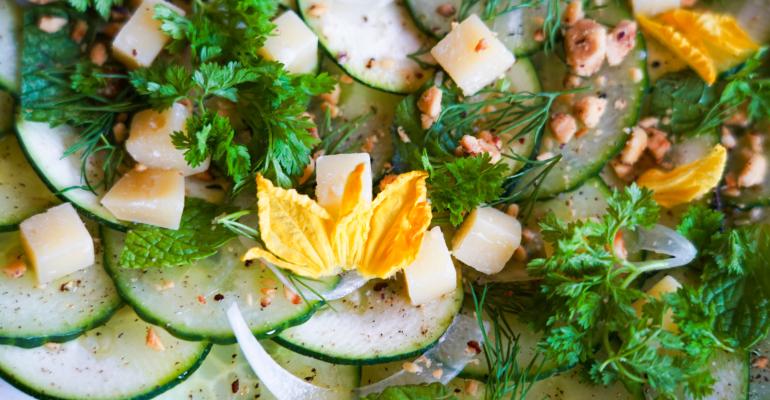Squash doesn’t seem like the most charismatic of vegetables. Even the name sounds like a failure. But many chefs are into them. They say each one has its own unique qualities, with summer varieties offering fresh, clean tastes and winter ones providing sweetness and a sort of implied richness, despite their low fat content, that can help lighter dishes seem more satisfying.
“Most people think squash is boring, but I think it’s fun to find ways to liven it up and surprise quests with new presentations, tastes, and textures,” said Ryan Pera, chef of Coltivare in Houston, who grows summertime squashes such as zucchini, also known as courgette, and crookneck in the restaurant’s garden.
He slices the zucchini paper-thin and uses it raw with cucumber, which it resembles and he said makes for nice visual appeal, and serves it as a carpaccio topped with crushed hazelnuts, squash blossoms, garden herbs, thinly shaved onions, and Sapore del Piave cheese, all dressed in a red wine vinaigrette.
Ryan Ratino, the chef of Bresca and Jônt restaurants in Washington, D.C., is a fan of zucchini, too.
“My team kind of gives me some shit for it, but I love to eat it like crudités — like summer squashes dipped in ranch dressing as a snack. … Shaved raw, lightly grilled and charred, they’re so versatile in the summertime.”
Rachel Saxton, chef of the new West End Social at the Aspen Meadows resort in Aspen, Colo., likes a variety that’s in season in late summer and early autumn.
“My favorite squash to eat simply roasted and cut into pieces [is] delicata squash,” she said. “Such delicate squash flavor with edible skin that packs a punch. Simply roasted in half with a little of salt, lemon zest, butter and chives! The texture of the skin with the moist dense inside makes it absolutely delicious on its own.”
The difference between chefs’ love for squash and consumer perception might be reflected in Technomic’s Ignite menu data, which indicates that mentions of squash on United States menus overall decreased by 7% between the end of 2022 and the end of 2023. But butternut squash soup mentions are up by 19.6%, and squash mentions in fine-dining restaurants are up by 8%.
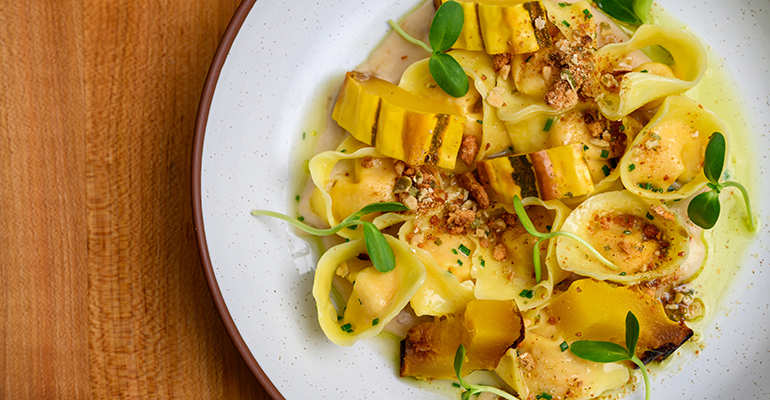
Rachel Saxton, chef of West End Social at the Aspen Meadows resort in Aspen, Colo., used delicata squash in a tortellini dish.
One big squash advocate is Dan Barber, chef of Blue Hill at Stone Barns in Pocantico Hills, N.Y., and Family Meal at Blue Hill in New York City.
Barber also is the founder of a seed company, Row 7, that essentially got its start developing new squash varieties, including the popular koginut, a variation of butternut that is now grown nationwide.
That and other winter squash varieties, including honeypatch and honeynut, were developed for Row 7 by Cornell University expert on plant breeding and genetics Michael Mazourek.
Unlike many breeding efforts, which often focus on long shelf-lives, high yields, and disease resistance, Mazourek’s focus has been on flavor, while also taking into account those other factors that make them economically viable.
“Much of modern squash has been bred to be harvested unripe, which does you no favors,” Barber said, since unripe squashes are less sweet and less flavorful overall.
“That’s why everyone’s told to add butter and maple syrup when you roast squash, because it’s got nothing in it. But if you select it for flavor you really don’t need to add anything. It’s one of the most miraculous vegetables.”
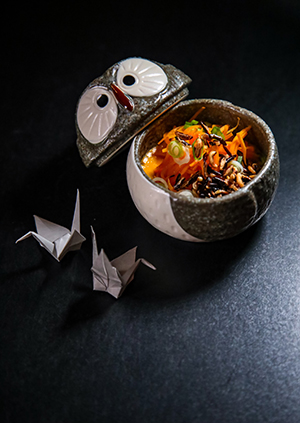 Photo: At Cranes in Washington, D.C., chef Pepe Moncayo made a vegan version of chawanmushi with butternut squash.
Photo: At Cranes in Washington, D.C., chef Pepe Moncayo made a vegan version of chawanmushi with butternut squash.
He said Mazourek’s approach was to breed varieties with “drier matter” and less water “so you’re actually getting more squash per bite.”
He added that, while many heirloom squash varieties are delicious, they often don’t have the high yield and disease resistant qualities of the ones Mazourek has developed.
Like many chefs, Barber makes a lot of purées of roasted winter squash.
“It’s so unctuous and rich that you don’t really need to add much of anything,” he said.
He also likes to cut them into brick-like rectangles and roast them.
“It just ends up looking like a steak,” he said.
Additionally, Barber ferments whole winter squash in 2% salt brine, roasts it, purées it and serves it instead of butter in the winter.
“Cows don’t milk during the winter, so we don’t have butter in the restaurant, but we serve this ‘squash butter’ instead. By fermenting it we give it a little tang,” he said.
At West End Social, Saxton likes to roast kabocha squash because of its ”bright orange flesh with a dry waxy texture … that makes it a very versatile product.” She said she uses it in pasta fillings, soups, or simply roasted with a little lemon and butter.
At Jônt, Ratino uses black futsu squash from Karma Farm in Maryland to make a version of the savory Japanese custard chawanmushi for the restaurant’s tasting menu. He roasts the squash and mixes it with soymilk, cooks it into a custard and finishes it with oil extracted from the squash seeds (he slowly roasts them, then runs them through a small grinder and collects the oil).
He serves it with Hokkaido sea urchin.
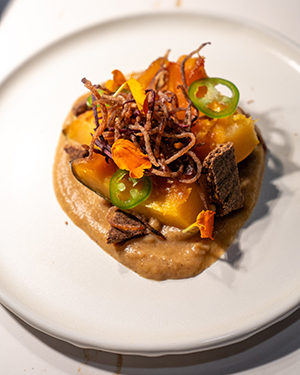 Photo: At Miles, The Prince, in White Plains, N.Y., Eric Bach used roasted acorn squash and acorn squash purée in a dish garnished with shoestring purple potato fries, fried serrano peppers and buckwheat crackers.
Photo: At Miles, The Prince, in White Plains, N.Y., Eric Bach used roasted acorn squash and acorn squash purée in a dish garnished with shoestring purple potato fries, fried serrano peppers and buckwheat crackers.
Downstairs from Jônt at the more casual Bresca, Ratino roasts squash and separately juices a sweet squash, reduces that and adds it to the purée. “You have no dairy, no butter or cream, but you have a luxurious texture, like velvet, that feels fatty, but it’s not,” he said.
In spring and summer he uses squashes such as courgettes and patty pan with Thai basil and romesco sauce to plate with shellfish and summer tomato dishes. Courgettes also go into salads with radicchio and an aged sherry-and-foie-gras vinaigrette.
Similar to Ratino, Pepe Moncayo, the chef of Cranes, also in D.C., has made a squash chawanmushi by combining eggs, butternut squash juice, diced butternut squash that he ferments with salt for 6 days, soy sauce, sake, mirin, and a dashi made with butternut squash and lemon grass as well as the usual kombu seaweed, but not bonito flakes, making the dish vegetarian.
Then he garnished it with raw butternut squash spirals and scallions dressed in butternut squash vinegar, rayu oil (the oil made with sesame oil, ginger, garlic, scallion and chile that’s often served as a condiment with ramen) and puffed wild rice.
Kishen Jagmohan, the chef of Riverpark in New York City, uses a variety of squashes in the fall and winter, including acorn, Georgia candy, butternut, and koginut.
“They’re all meant for different things, and if you know how to manipulate the textures … you get a really nice end product,” he said.
Acorn squash is coated in a shawarma spice blend and fried at Riverpark in New York City, where chef Kishen Jagmohan serves it over French lentils and garnishes it with riced cauliflower, pumpkin seeds and am herbaceous watercress salad.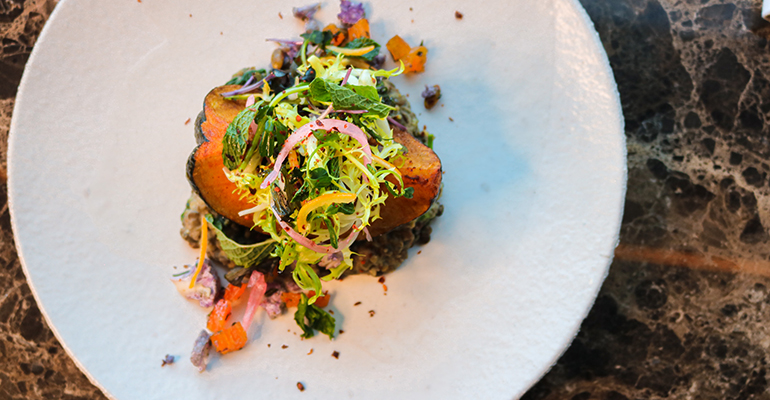
He uses acorn squash, which he appreciates for its “fatty” texture. Instead of roasting it he steams it for 10-15 minutes so it doesn’t dry out and then coats it in a shawarma spice that includes cumin, turmeric, coriander, garlic powder, paprika, cloves, and cayenne pepper. He lets those spices latch on for around 10 minutes and then fries the squash for a couple of minutes so they have a crunchy exterior but are creamy inside. The squash is served over French lentils that have been cooked with mirepoix, shallots, garlic, and ginger and finished with some coconut milk. They’re topped with riced cauliflower sautéed with rehydrated dried apricots, along pumpkin seeds seasoned with his shawarma spice, and a salad of watercress, preserved lemon, pickled onions, mustard greens, cilantro, mint, and parsley in a lemon vinaigrette.
Eric Brach, chef of Miles, The Prince, in White Plains, N.Y., also is a fan of acorn squash.
He slices it into crescents, coats them in salted caramel with a little rosemary and roasts them until tender.
Separately, he makes a purée of acorn squash by slicing them in half, filling the centers with garlic and onions tossed with salt, pepper, and olive oil, roasting them and then puréeing them (minus the skin).
He serves the squash with shoestring purple potato fries dressed with a little rosemary, and garnishes the dish with lightly fried serrano pepper coins dressed in apple cider vinegar and honey, and serves them with buckwheat crackers.
At Carlotto restaurant in New York City, chef Andy Kitko stuffs tortelli pasta with butternut squash.
He cuts them in half, scoops out the seeds, coats them with olive oil, salt and pepper and roasts them until they’re caramelized and very soft. He then scoops out the flesh and purées it with mascarpone cheese, salt and pepper.
“Depending on the time of year and what’s going on with the squash, if it’s a little wet we’ll hang it in cheesecloth overnight,” he said.
He serves it in a brown butter and sage sauce finished with grated Parmesan cheese and crushed amaretti cookies.
“You have this really sweet and savory thing going on which accentuates the squash,” he said. “That sensation really stimulates the tastebuds.”
He said the squash is substantial enough that people don’t miss meat.
“Even though it’s a vegetable, it really satisfied when you eat it,” he said.
Contact Bret Thorn at [email protected]
